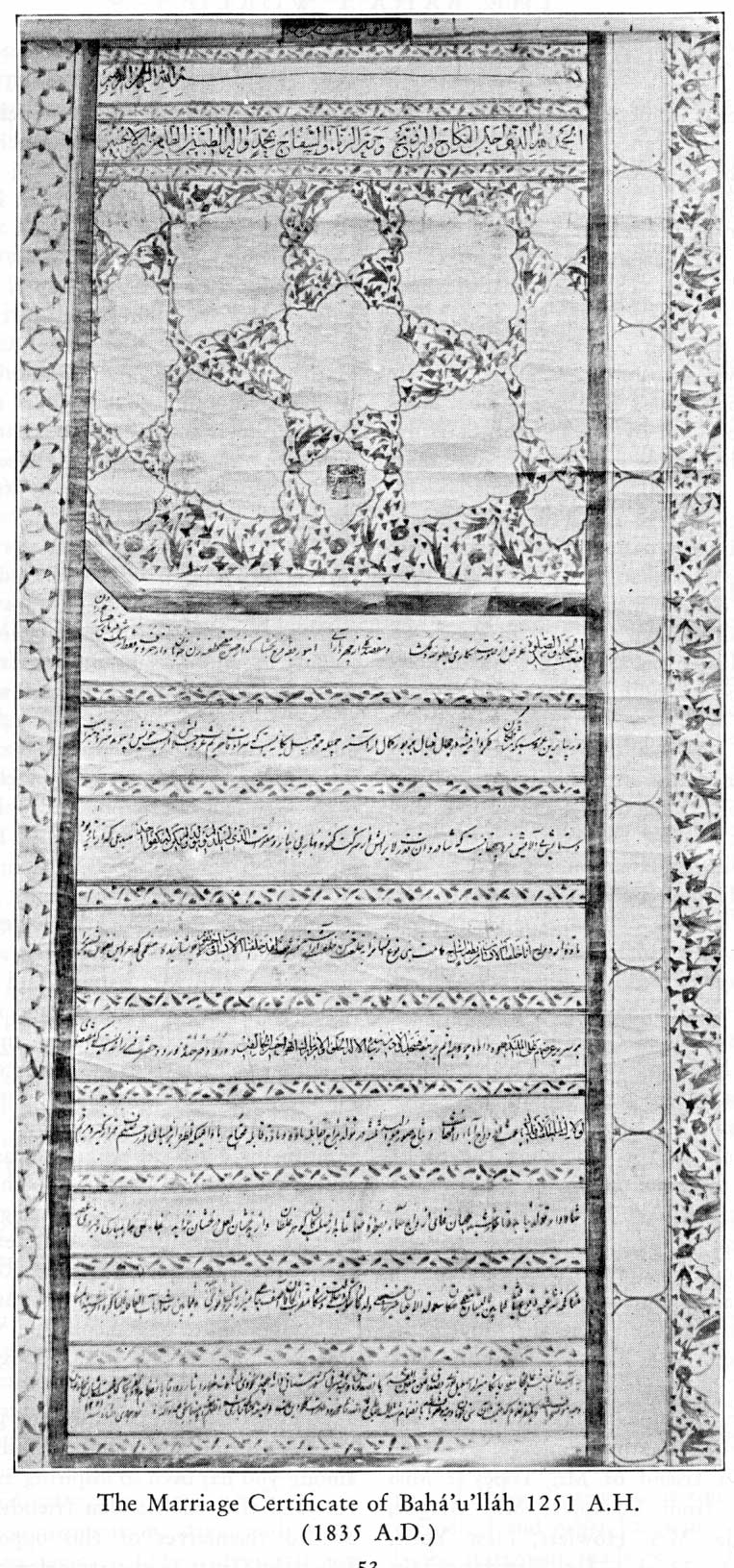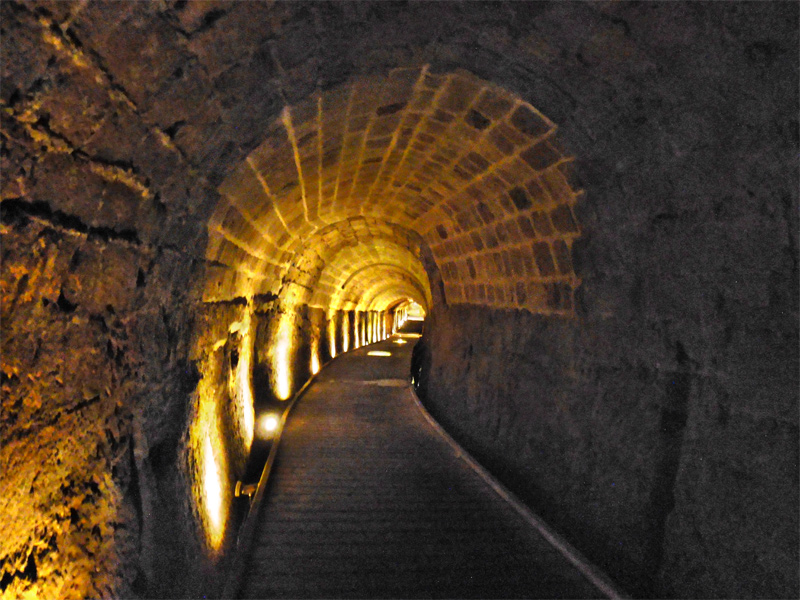|
MunûÙrih KhûÀnum
MunûÙrih KëhûÀnum (; 1847April 28, 1938) was the wife of ò£Abdu'l-BahûÀ, a prominent figure in the BahûÀò¥ûÙ Faith. She was entitled the Holy Mother. Her memoirs, first published in 1924, are regarded as one of the first published memoirs by a Persian woman in the 20th century. Childhood and early years MunûÙrih KhûÀnum was born FûÀÿÙimih NahrûÙ, the eldest child of Muhammad ò£AlûÙ NahrûÙ and his wife, ZahrûÀ of IsfahûÀn in Isfahan. The NahrûÙ family was a prominent family in the city, and her family were one of the first BûÀbûÙs of Isfahan who later became eminent BahûÀò¥ûÙs of Persia. The family were also highly connected with high-ranking nobles and clerics of the city. Her maternal uncle was killed at the age of fourteen in Persia because of his religion. MunûÙrih's birth came as a surprise to her parents. Her father was previously married and had no children. Upon his wife's death, he remarried ZahrûÀ KhûÀnum. MunûÙrih's birth in 1847 did not occur until some ten ye ... [...More Info...] [...Related Items...] OR: [Wikipedia] [Google] [Baidu] |
MûÙrzûÀ Mû¤sûÀ
MûÙrzûÀ Mû¤sûÀ (; d. 1887) was the only full brother of BahûÀò¥u'llûÀh, meaning that they shared the same mother and father. He was later named by Shoghi Effendi as one of the nineteen Apostles of BahûÀò¥u'llûÀh. The life of MûÙrzûÀ Mû¤sûÀ was so bound up with that of BahûÀò¥u'llûÀh himself, that his life and background mirror the life and travels of BahûÀò¥u'llûÀh. He was an integral part of correspondence between BahûÀò¥u'llûÀh and the BahûÀò¥ûÙs. He experienced the same imprisonment, exile, assaults, and degrading circumstances that were given to the small band of family members associated with BahûÀò¥u'llûÀh and ò£Abdu'l-BahûÀ. MûÙrzûÀ Mû¤sûÀ remained a loyal and faithful follower until he died. BahûÀò¥u'llûÀh used MûÙrzûÀ Mû¤sûÀ as an example to show his respect for the law. When an official expressed hesitation to inflict punishment on one of the followers of BahûÀò¥u'llûÀh who had committed a crime, he replied: :"Tell him, no one in this world can claim any relationsh ... [...More Info...] [...Related Items...] OR: [Wikipedia] [Google] [Baidu] |
ûsûÙyih KhûÀnum
ûsûÙyih KëhûÀnum ( 18201886) was the first wife of BahûÀò¥u'llûÀh, the founder of the BahûÀò¥ûÙ Faith. She is also known by her titles of NavvûÀb, Bû¤yû¤k KëhûÀnum or Hadrat-i-KëhûÀnum. KëhûÀnum is a title usually given to a Persian lady and is equivalent to madam or dame. BahûÀò¥u'llûÀh and ûsûÙyih KhûÀnum were known as the ''Father of the Poor'' and the ''Mother of Consolation'' for their extraordinary generosity and regard for the impoverished. BahûÀò¥u'llûÀh, along with ûsûÙyih KhûÀnum and her children, are regarded as the BahûÀò¥ûÙ holy family. Background ûsûÙyih KhûÀnum was born ûsûÙyih Yalrû¤dûÙ the only daughter of MûÙrzûÀ IsmûÀò¥ûÙl Yalrû¤dûÙ, an aristocrat and minister in the Qajar court in the village of Yal Rud in Mazandaran. She had one brother MûÙrzûÀ Mahmû¤d who did not become a follower of BûÀbism nor of the BahûÀò¥ûÙ Faith. The Yalrû¤dûÙ family held a prominent position in the nobility, providing ûsûÙyih with an upbringing of exceptional privileg ... [...More Info...] [...Related Items...] OR: [Wikipedia] [Google] [Baidu] |
BahûÙyyih KhûÀnum
BahûÙyyih KhûÀnum (1846 ã 15 July 1932) was the only daughter of BahûÀò¥u'llûÀh, the founder of the BahûÀò¥ûÙ Faith, and ûsûÙyih KhûÀnum. She was born in 1846 with the given name Fatimih Sultan, and was entitled "Varaqiy-i-'UlyûÀ" or "Greatest Holy Leaf". Brought up through the trying times her family lived through, in adulthood she served the interests of the religion and was even occasionally trusted with running the affairs of the religion. Greatly favoured by BahûÀ'u'llûÀh, she is seen within the BahûÀò¥ûÙ Faith as one of the greatest women to have lived. According to BahûÀò¥ûÙs, every Progressive revelation (BahûÀò¥ûÙ), dispensation has one particular holy woman or "immortal heroine". In the time of Jesus it was the Virgin Mary, the time of Muhammad it was his daughter Fatima Zahra and during the BûÀb's dispensation it was TûÀhirih. BahûÀò¥ûÙs believe that BahûÙyyih KhûÀnum is the outstanding heroine of the BahûÀò¥ûÙ dispensation. During the lifetime of her father Tehra ... [...More Info...] [...Related Items...] OR: [Wikipedia] [Google] [Baidu] |
Ottoman Empire
The Ottoman Empire (), also called the Turkish Empire, was an empire, imperial realm that controlled much of Southeast Europe, West Asia, and North Africa from the 14th to early 20th centuries; it also controlled parts of southeastern Central Europe, between the early 16th and early 18th centuries. The empire emerged from a Anatolian beyliks, ''beylik'', or principality, founded in northwestern Anatolia in by the Turkoman (ethnonym), Turkoman tribal leader Osman I. His successors Ottoman wars in Europe, conquered much of Anatolia and expanded into the Balkans by the mid-14th century, transforming their petty kingdom into a transcontinental empire. The Ottomans ended the Byzantine Empire with the Fall of Constantinople, conquest of Constantinople in 1453 by Mehmed II. With its capital at History of Istanbul#Ottoman Empire, Constantinople (modern-day Istanbul) and control over a significant portion of the Mediterranean Basin, the Ottoman Empire was at the centre of interacti ... [...More Info...] [...Related Items...] OR: [Wikipedia] [Google] [Baidu] |
Akko
Acre ( ), known in Hebrew as Akko (, ) and in Arabic as Akka (, ), is a city in the coastal plain region of the Northern District of Israel. The city occupies a strategic location, sitting in a natural harbour at the extremity of Haifa Bay on the coast of the Mediterranean's Levantine Sea."Old City of Acre." , World Heritage Center. World Heritage Convention. Web. 15 April 2013 Aside from coastal trading, it was an important waypoint on the region's coastal road and the road cutting inland along the Jezreel Valley. The first settlement d ... [...More Info...] [...Related Items...] OR: [Wikipedia] [Google] [Baidu] |
House Of ò£Abbû¤d
A house is a single-unit residential building. It may range in complexity from a rudimentary hut to a complex structure of wood, masonry, concrete or other material, outfitted with plumbing, electrical, and heating, ventilation, and air conditioning systems.Schoenauer, Norbert (2000). ''6,000 Years of Housing'' (rev. ed.) (New York: W.W. Norton & Company). Houses use a range of different roofing systems to keep precipitation such as rain from getting into the dwelling space. Houses generally have doors or locks to secure the dwelling space and protect its inhabitants and contents from burglars or other trespassers. Most conventional modern houses in Western cultures will contain one or more bedrooms and bathrooms, a kitchen or cooking area, and a living room. A house may have a separate dining room, or the eating area may be integrated into the kitchen or another room. Some large houses in North America have a recreation room. In traditional agriculture-oriented societies, domes ... [...More Info...] [...Related Items...] OR: [Wikipedia] [Google] [Baidu] |
Covenant-breakers
Covenant-breaker is a term used in the BahûÀò¥ûÙ Faith to refer to a person who has been excommunicated from the BahûÀò¥ûÙ community for breaking the Covenant of BahûÀò¥u'llûÀh, meaning actively promoting schism in the religion or otherwise opposing the legitimacy of the chain of succession of leadership. Excommunication among BahûÀò¥ûÙs is rare and not used for transgressions of community standards, intellectual dissent, or conversion to other religions. Instead, it is the most severe punishment, reserved for suppressing organized dissent that threatens the unity of believers. Currently, the Universal House of Justice has the sole authority to declare a person a Covenant-breaker, and once identified, all BahûÀò¥ûÙs are expected to shun them, even if they are family members. According to ò£Abdu'l-BahûÀ, Covenant-breaking is a contagious disease. The BahûÀò¥ûÙ writings forbid association with Covenant-breakers and BahûÀò¥ûÙs are urged to avoid their literature, thus providing an ... [...More Info...] [...Related Items...] OR: [Wikipedia] [Google] [Baidu] |
MûÙrzûÀ Muhammad ò£AlûÙ
MûÙrzûÀ Muhammad ò£AlûÙ ( 16 December 1853 ã 10 December 1937) was the second surviving son of BahûÀò¥u'llûÀh, the founder of the BahûÀò¥ûÙ Faith, and the first from BahûÀò¥u'llûÀh's second wife Fatimih. He is well-known for an attempted schism in which he claimed leadership over his half-brother ò£Abdu'l-BahûÀ, and was rejected by the overwhelming majority of BahûÀò¥ûÙs, who regard him as a Covenant-breaker. The only result of his unsuccessful leadership attempt was to alienate most of the family of BahûÀò¥u'llûÀh from ò£Abdu'l-BahûÀ. His schism was short lived and no longer exists; by the 1960s his descendants had largely melded into Muslim society and had no collective religious life. Muhammad ò£AlûÙ was born in Baghdad among the group of Iranians exiled from Iran for their adherence to the BûÀbûÙ Faith. He would follow the family into further exiles into Istanbul, Edirne, and `Akka. As a teenager in Edirne, he began transcribing the writings of BahûÀò¥u'llûÀh, and att ... [...More Info...] [...Related Items...] OR: [Wikipedia] [Google] [Baidu] |
BahûÀò¥u'llûÀh's Family
BahûÀò¥u'llûÀh was the founder of the BahûÀò¥ûÙ Faith. He was born in 1817 to KhadûÙjih KhûÀnum and MûÙrzûÀ Buzurg of Nur (in the province of Mazandaran), a Persian people, Persian nobleman, and went on to be a leader in the BûÀbism, BûÀbûÙ movement, and then established the BahûÀò¥ûÙ Faith in 1863. BahûÀò¥u'llûÀh's family consists of his three wives and the children of those wives. Titles of descendants One of BahûÀò¥u'llûÀh's titles is Sadratu'l-MuntahûÀ, which translates from Arabic as ''the tree beyond which there is no passing'' (a quote from Qurò¥an 53:14). In this connection, BahûÀò¥u'llûÀh Persian names, entitled his descendants with terms relating to the Sadratu'l-MuntahûÀ. His male descendants were given the title of AghsûÀn, AgëhsûÀn (Arabic language, Arabic for "Branches") which in singular form is "''Gëhusn''". In particular, four of his sons were given specific "branch" titles: * ò£Abdu'l-BahûÀ: ''GëhuÿÈn-i-Aò£Ã¤am'' ( "The Most Great Branch"). * MûÙrzûÀ Muhamma ... [...More Info...] [...Related Items...] OR: [Wikipedia] [Google] [Baidu] |
Munib Shahid
Munib Jalal Shahid (; 1908ã1973) was Chairman of Hematology and Oncology at the Faculty of Medicine of the American University of Beirut. He built the hematology laboratory at the Faculty of Medicine, a development that increased research output significantly. The Dr. Munib Shahid Award is presented annually at the American University of Beirut to the fourth year medical student demonstrating the best performance in internal medicine and a mature character. Munib Shahid was born in 1908 in Acre, Palestine to a prominent BahûÀò¥ûÙ lineage. He was the great-grandson of BahûÀò¥u'llûÀh, the founder-prophet of the BahûÀò¥ûÙ Faith. His parents were Jalal, an AfnûÀn, and Rû¤Ã¡ËûÀ, a daughter of ò£Abdu'l-BahûÀ. His paternal grandfather was Muhammad-Hasan, titled " King of the Martyrs". In 1944, he married Serene Husseini according to the Muslim rites. She was related to the Grand Mufti of Jerusalem, an enemy of the BahûÀò¥ûÙs. Shoghi Effendi, Munib's cousin and then head of the Bahÿ¢§ ... [...More Info...] [...Related Items...] OR: [Wikipedia] [Google] [Baidu] |






